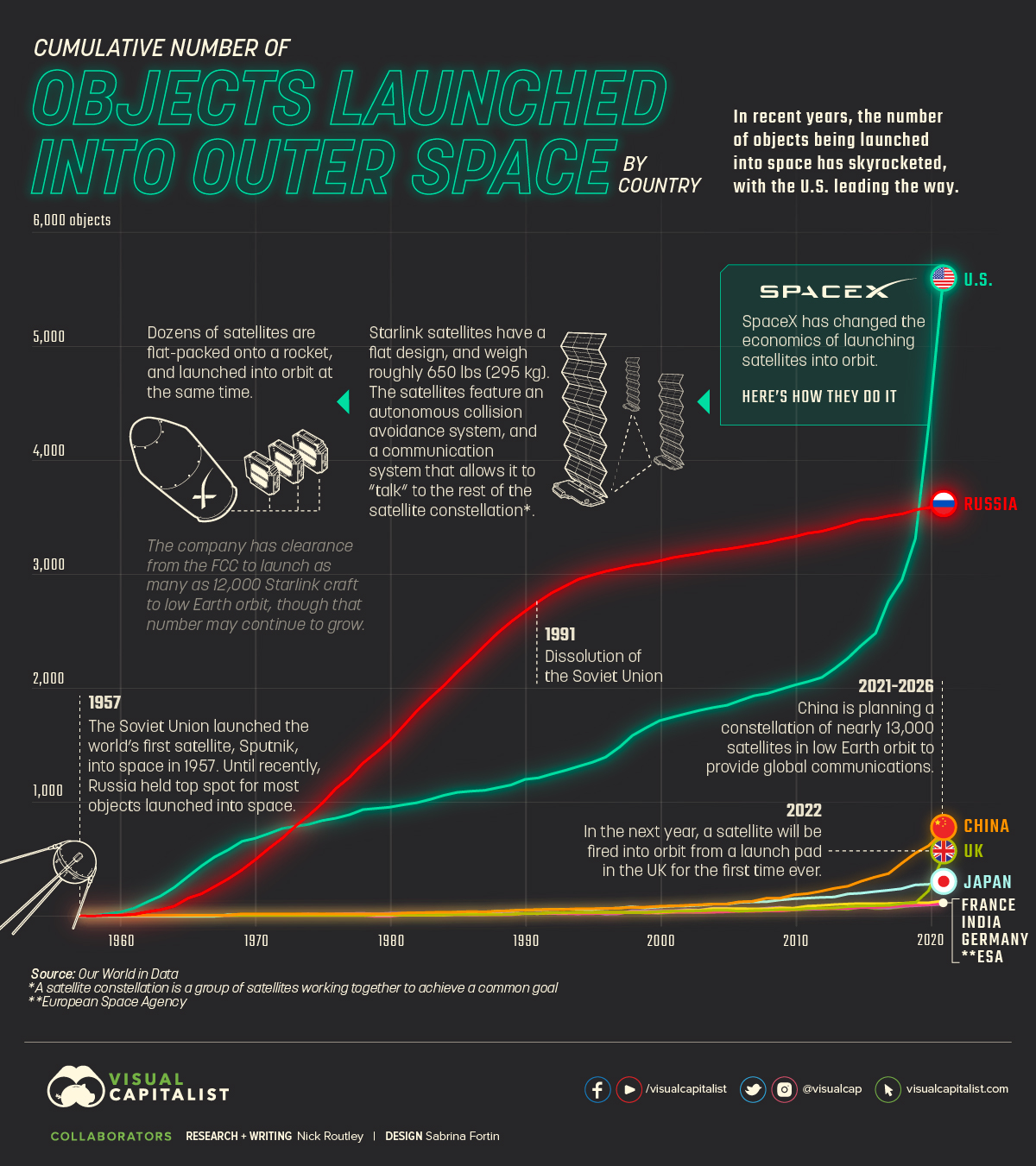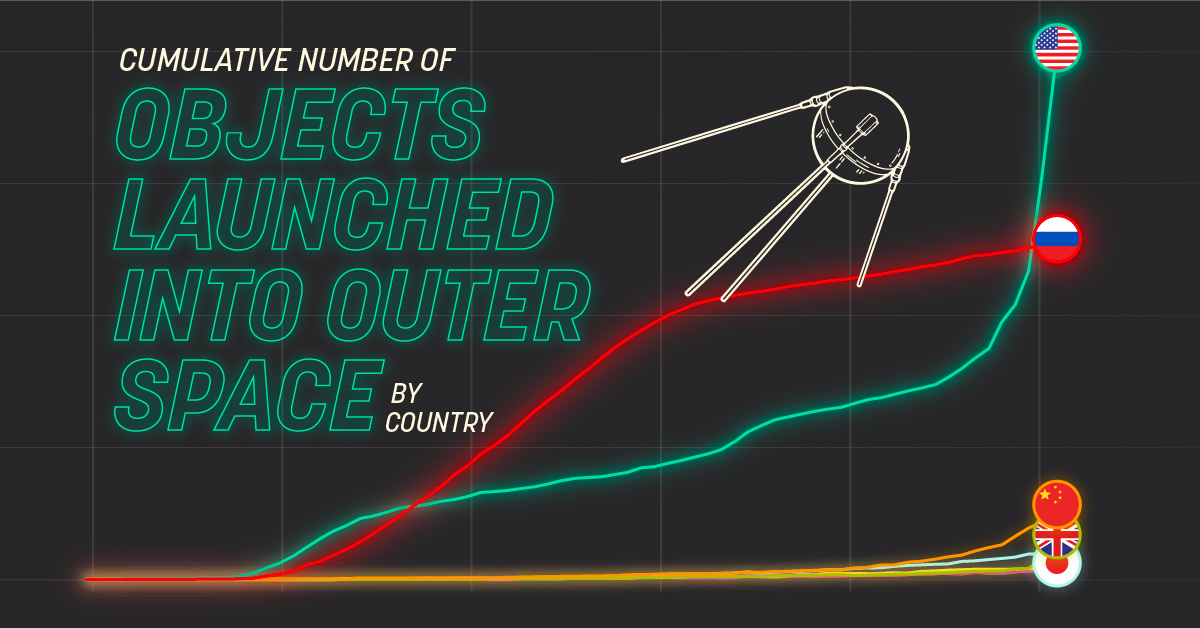Misc
Visualized: Which Countries are Dominating Space?

Visualized: Which Countries are Dominating Space
Believe it or not, there is a lot of stuff in space. In fact, our atmosphere is filled with more than 11,000 objects that have been launched since the foray into space began.
The Space Race started during the Cold War, and early on the Soviet Union dominated when it came to the amount of devices and objects launched into our atmosphere. But a few years ago, the U.S. took back that title with Elon Musk’s SpaceX helping lead the charge.
This visual, using data from Our World in Data, breaks down the amount of objects launched into space by country over time.
What Gets Launched Into Space?
What are the objects being sent into our atmosphere and why are they so important? Here’s a look at just a few:
- Satellites
- Crewed spacecraft
- Probes
- Space station flight equipment
Probes and landers like the Mars Rover, for example, have helped scientists explore other planets. Satellites provide us with everyday necessities like cell phone service, far reaching television signals, satellite imagery, and GPS.
As of late 2021, there were around 4,852 operational satellites in orbit—2,944 belonging to the United States. Here’s a quick look at what the U.S. uses its satellites for:
- Commercial: 2,516
- Military: 230
- Government: 168
- Civil: 30
Many satellites in orbit, however, are no longer functional. In fact, there is a lot of junk in space—according to NASA, there are over 27,000 pieces of space debris in orbit.
The Space Race, by Country
The venture into outer space began during the Cold War when the USSR launched the first satellite, Sputnik 1 in 1957. After this, the U.S. and Soviet Union entered a definitive competition between technological advancements and scientific exploration into space—an extension of the battle between political ideologies.
Few countries have come close in matching either the U.S. or Russia so far. Here’s a look at the cumulative number of objects different countries have launched into orbit and beyond.
| Rank | Country | Cumulative Number of Objects Launched into Space |
|---|---|---|
| #1 | 🇺🇸 United States | 5,534 |
| #2 | 🇷🇺 Russia | 3,611 |
| #3 | 🇨🇳 China | 731 |
| #4 | 🇬🇧 UK | 515 |
| #5 | 🇯🇵 Japan | 300 |
| #6 | 🇫🇷 France | 130 |
| #7 | 🇮🇳 India | 127 |
| #8 | 🇩🇪 Germany | 114 |
| #9 | 🇨🇦 Canada | 82 |
| #10 | 🇱🇺 Luxembourg | 53 |
| #11 | 🇮🇹 Italy | 52 |
| #12 | 🇰🇷 South Korea | 43 |
| #13 | 🇧🇷 Brazil | 39 |
| #14 | 🇦🇺 Australia | 36 |
| #15 | 🇧🇪 Belgium | 36 |
| #16 | 🇮🇱 Israel | 30 |
| #17 | 🇪🇸 Spain | 29 |
| #18 | 🇺🇾 Uruguay | 23 |
| #19 | 🇮🇩 Indonesia | 21 |
| #20 | 🇦🇷 Argentina | 20 |
| #21 | 🇸🇪 Sweden | 19 |
| #22 | 🇲🇽 Mexico | 18 |
| #23 | 🇸🇦 Saudi Arabia | 17 |
| #24 | 🇦🇪 United Arab Emirates | 17 |
| #25 | 🇹🇼 Taiwan | 17 |
| #26 | 🇫🇮 Finland | 17 |
| #27 | 🇹🇷 Turkey | 16 |
| #28 | 🇨🇭 Switzerland | 15 |
| #29 | 🇹🇭 Thailand | 14 |
| #30 | 🇳🇿 New Zealand | 14 |
| #31 | 🇳🇴 Norway | 14 |
| #32 | 🇳🇱 Netherlands | 13 |
| #33 | 🇩🇰 Denmark | 12 |
| #34 | 🇪🇬 Egypt | 9 |
| #35 | 🇰🇿 Kazakhstan | 9 |
| #36 | 🇲🇾 Malaysia | 9 |
| #37 | 🇱🇹 Lithuania | 9 |
| #38 | 🇺🇦 Ukraine | 8 |
| #39 | 🇵🇱 Poland | 8 |
| #40 | 🇻🇳 Vietnam | 7 |
| #41 | 🇵🇭 Philippines | 7 |
| #42 | 🇨🇿 Czechia | 7 |
| #43 | 🇩🇿 Algeria | 6 |
| #44 | 🇮🇷 Iran | 6 |
| #45 | 🇵🇰 Pakistan | 6 |
| #46 | 🇳🇬 Nigeria | 5 |
| #47 | 🇿🇦 South Africa | 5 |
| #48 | 🇭🇺 Hungary | 5 |
| #49 | 🇻🇪 Venezuela | 4 |
| #50 | 🇵🇪 Peru | 4 |
| #51 | 🇨🇱 Chile | 4 |
| #52 | 🇲🇦 Morocco | 3 |
| #53 | 🇦🇿 Azerbaijan | 3 |
| #54 | 🇬🇷 Greece | 3 |
| #55 | 🇪🇪 Estonia | 3 |
| #56 | 🇧🇾 Belarus | 3 |
| #57 | 🇧🇬 Bulgaria | 3 |
| #58 | 🇦🇹 Austria | 3 |
| #59 | 🇨🇴 Colombia | 2 |
| #60 | 🇪🇨 Ecuador | 2 |
| #61 | 🇰🇵 North Korea | 2 |
| #62 | 🇧🇩 Bangladesh | 2 |
| #63 | 🇵🇬 Papua New Guinea | 2 |
| #64 | 🇸🇰 Slovakia | 2 |
| #65 | 🇸🇮 Slovenia | 2 |
| #66 | 🇬🇭 Ghana | 1 |
| #67 | 🇪🇹 Ethiopia | 1 |
| #68 | 🇰🇪 Kenya | 1 |
| #69 | 🇷🇼 Rwanda | 1 |
| #70 | 🇦🇴 Angola | 1 |
| #71 | 🇬🇹 Guatemala | 1 |
| #72 | 🇨🇷 Costa Rica | 1 |
| #73 | 🇧🇴 Bolivia | 1 |
| #74 | 🇵🇾 Paraguay | 1 |
| #75 | 🇲🇳 Mongolia | 1 |
| #76 | 🇹🇲 Turkmenistan | 1 |
| #77 | 🇯🇴 Jordan | 1 |
| #78 | 🇶🇦 Qatar | 1 |
| #79 | 🇱🇰 Sri Lanka | 1 |
| #80 | 🇳🇵 Nepal | 1 |
| #81 | 🇧🇹 Bhutan | 1 |
| #82 | 🇱🇦 Laos | 1 |
| #83 | 🇱🇻 Latvia | 1 |
| #84 | 🇷🇴 Romania | 1 |
| #85 | 🇲🇨 Monaco | 1 |
| #86 | 🇵🇹 Portugal | 1 |
One important disclaimer here is that not all of these countries have orbital launch capabilities, meaning that although the satellite in space may belong to a certain country, that doesn’t mean that it was launched by said country. For example, the UK’s first launch in 1971 was out of Australia and France’s first launch took place in Algeria in 1965.
In total, around 86 countries have attempted some kind of entry into space. However, as of 2022, only 11 countries have the ability to send objects into space using their own launch vehicles, and only three—the U.S., Russia, and China—have ever launched people into outer space.
The Future of Space
With corporations beginning to take the lead in this new frontier, the landscape of space launches is changing. In 2019 Starlink, a constellation of satellites which provides 36 countries with internet access, was launched. With over 2,200 Starlink satellites in the sky and counting, SpaceX’s ultimate goal is global internet coverage; China is planning a similar venture.
Beyond useful satellites and scientific exploration, other potential space industries are emerging.
As one example, the business of commercial space tourism is no longer a futuristic concept. In late 2021, famous billionaire and founder of Virgin Galactic, Richard Branson flew briefly into space on a private flight. Jeff Bezos, having founded Blue Origin, followed shortly after.
Today, both Blue Origin and Virgin Galactic are licensed by the Federal Aviation Administration for passenger space travel. However, if you want to be launched into space, it will cost you around $250,000-$500,000.
VC+
VC+: Get Our Key Takeaways From the IMF’s World Economic Outlook
A sneak preview of the exclusive VC+ Special Dispatch—your shortcut to understanding IMF’s World Economic Outlook report.

Have you read IMF’s latest World Economic Outlook yet? At a daunting 202 pages, we don’t blame you if it’s still on your to-do list.
But don’t worry, you don’t need to read the whole April release, because we’ve already done the hard work for you.
To save you time and effort, the Visual Capitalist team has compiled a visual analysis of everything you need to know from the report—and our VC+ Special Dispatch is available exclusively to VC+ members. All you need to do is log into the VC+ Archive.
If you’re not already subscribed to VC+, make sure you sign up now to access the full analysis of the IMF report, and more (we release similar deep dives every week).
For now, here’s what VC+ members get to see.
Your Shortcut to Understanding IMF’s World Economic Outlook
With long and short-term growth prospects declining for many countries around the world, this Special Dispatch offers a visual analysis of the key figures and takeaways from the IMF’s report including:
- The global decline in economic growth forecasts
- Real GDP growth and inflation forecasts for major nations in 2024
- When interest rate cuts will happen and interest rate forecasts
- How debt-to-GDP ratios have changed since 2000
- And much more!
Get the Full Breakdown in the Next VC+ Special Dispatch
VC+ members can access the full Special Dispatch by logging into the VC+ Archive, where you can also check out previous releases.
Make sure you join VC+ now to see exclusive charts and the full analysis of key takeaways from IMF’s World Economic Outlook.
Don’t miss out. Become a VC+ member today.
What You Get When You Become a VC+ Member
VC+ is Visual Capitalist’s premium subscription. As a member, you’ll get the following:
- Special Dispatches: Deep dive visual briefings on crucial reports and global trends
- Markets This Month: A snappy summary of the state of the markets and what to look out for
- The Trendline: Weekly curation of the best visualizations from across the globe
- Global Forecast Series: Our flagship annual report that covers everything you need to know related to the economy, markets, geopolitics, and the latest tech trends
- VC+ Archive: Hundreds of previously released VC+ briefings and reports that you’ve been missing out on, all in one dedicated hub
You can get all of the above, and more, by joining VC+ today.
-

 Mining1 week ago
Mining1 week agoGold vs. S&P 500: Which Has Grown More Over Five Years?
-

 Markets2 weeks ago
Markets2 weeks agoRanked: The Most Valuable Housing Markets in America
-

 Money2 weeks ago
Money2 weeks agoWhich States Have the Highest Minimum Wage in America?
-

 AI2 weeks ago
AI2 weeks agoRanked: Semiconductor Companies by Industry Revenue Share
-

 Markets2 weeks ago
Markets2 weeks agoRanked: The World’s Top Flight Routes, by Revenue
-

 Countries2 weeks ago
Countries2 weeks agoPopulation Projections: The World’s 6 Largest Countries in 2075
-

 Markets2 weeks ago
Markets2 weeks agoThe Top 10 States by Real GDP Growth in 2023
-

 Demographics2 weeks ago
Demographics2 weeks agoThe Smallest Gender Wage Gaps in OECD Countries

















